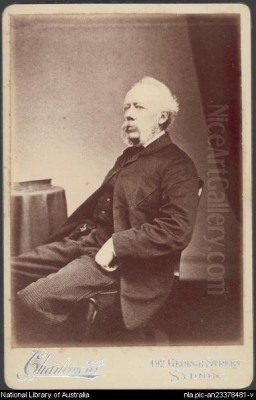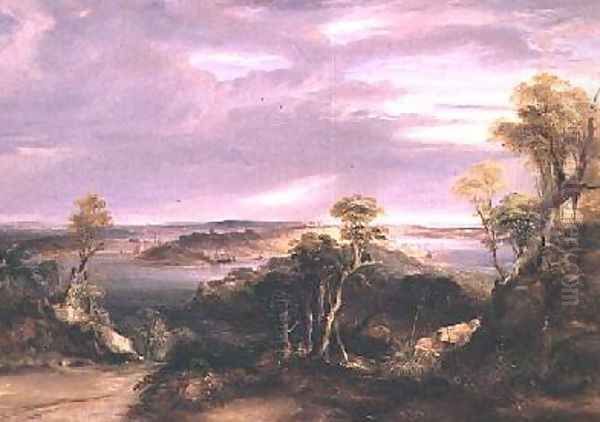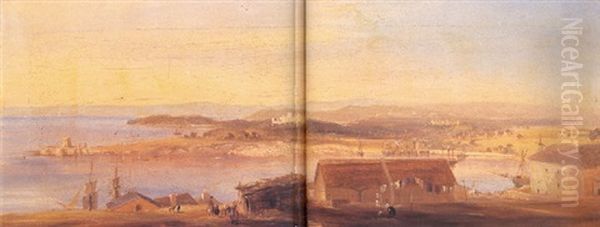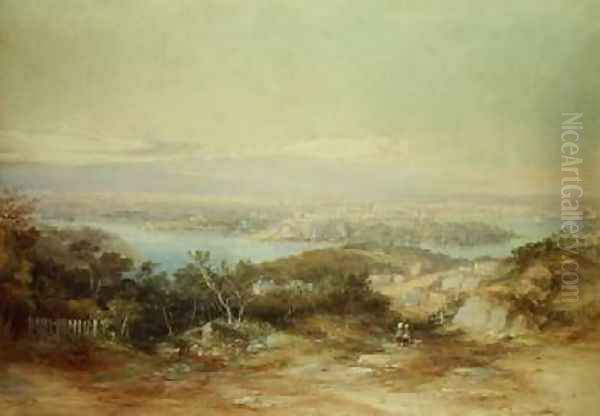Introduction: An Artist Between Worlds

Conrad Martens stands as a significant figure in the art history of colonial Australia. Born in London in 1801, he brought with him the traditions of English landscape painting, which he skillfully adapted to capture the unique light and scenery of his adopted homeland. His father, a German merchant, and his English mother provided him with a background that perhaps fostered an appreciation for different perspectives. Martens' legacy is intrinsically linked not only to his prolific output as a landscape artist in New South Wales but also to his remarkable participation in one of the most famous scientific expeditions of the 19th century – the voyage of HMS Beagle alongside Charles Darwin.
Martens received a solid education befitting his family's status. His formal artistic training began around 1816, placing him under the tutelage of the respected English landscape painter Anthony Van Dyke Copley Fielding. This instruction grounded him in the techniques of watercolour, a medium he would master and predominantly use throughout his career. His early development was shaped by the prevailing aesthetics of British landscape art, absorbing the principles and compositional strategies exemplified by masters like Claude Lorrain and the groundbreaking J.M.W. Turner.
Early Career and the Call of Adventure
Martens began his professional artistic life in England, honing his skills within the established art scene. However, his path took a dramatic turn towards exploration and adventure. He ventured to South America, a continent brimming with exotic landscapes that undoubtedly appealed to his artistic sensibilities. This move set the stage for a pivotal moment in his life and career.
In 1833, while in Montevideo, Martens encountered HMS Beagle, the vessel undertaking a crucial surveying and scientific mission under the command of Robert FitzRoy. The ship's official artist, Augustus Earle, had unfortunately fallen ill and needed to leave the expedition. Martens seized the opportunity and was hired to replace Earle, officially becoming the ship's draftsman. This appointment marked the beginning of an extraordinary chapter, placing him in close quarters with the young naturalist Charles Darwin.
The Voyage of HMS Beagle: Art Meets Science

Martens' time aboard the Beagle, though lasting less than two years, was profoundly influential. He sailed with the expedition through South American waters, notably Patagonia, documenting the landscapes, geological formations, and coastlines encountered. His role required keen observation and accurate rendering, skills that complemented the scientific objectives of the voyage. He produced numerous sketches and watercolours that served as visual records of the journey's findings.
During this period, Martens developed a deep and lasting friendship with Charles Darwin. Their shared experiences fostered mutual respect, and Darwin would later commission works from Martens based on sketches made during the voyage, intended for publications related to the expedition, such as Darwin's Journal of Researches. This connection highlights the interplay between artistic representation and scientific documentation that characterized the Beagle's mission. Martens also benefited from the scientific environment onboard, learning about meteorological observation from Commander FitzRoy, which likely enhanced his sensitivity to atmospheric effects in his later landscapes.
The landscapes Martens encountered in South America, particularly the vast, stark beauty of Patagonia, left a lasting impression. His work Cordillera of the Andes from the Santa Cruz River captures the serene yet imposing nature of these environments, showcasing his ability to convey scale and atmosphere through watercolour. This period was crucial in developing his eye for the exotic and the sublime in nature, preparing him for the unique challenges of depicting the Australian continent.
Arrival and Settlement in Australia
In 1835, HMS Beagle arrived in Sydney Harbour. For Martens, this marked the end of his voyage with Darwin and FitzRoy but the beginning of a new life chapter. Captivated by the beauty of the harbour and the potential opportunities in the burgeoning colony of New South Wales, Martens decided to disembark and make Sydney his permanent home. This decision proved fortuitous, as he quickly established himself as a leading artist in the colonial capital.
He arrived at a time when the colony was developing a sense of identity, and there was a growing market among the affluent settlers for depictions of their new environment. Martens' refined English style, combined with his ability to capture the specific qualities of the Australian landscape – its unique light, distinctive vegetation, and expansive vistas – resonated with the colonial elite. He became the most sought-after landscape painter in Sydney for several decades.
Artistic Style: English Tradition Meets Australian Light

Conrad Martens' artistic style was firmly rooted in the English picturesque tradition, heavily influenced by his training under Copley Fielding and his admiration for Claude Lorrain and J.M.W. Turner. He employed established compositional devices, often framing expansive views with foreground trees and using atmospheric perspective to create depth. However, he skillfully adapted these conventions to the Australian context.
His primary medium was watercolour, which he handled with exceptional delicacy and precision. He was adept at using both transparent washes to capture the brilliance of the Australian light and opaque bodycolour (gouache) to define details and create dramatic highlights. His technique involved careful layering of colours and a masterful use of chiaroscuro – the contrast between light and shadow – to enhance the mood and structure of his compositions.
Martens paid close attention to botanical detail, accurately rendering the distinctive forms of Australian flora, such as the Bottle Tree (Brachychiton rupestris). His works demonstrate a keen observation of natural phenomena, from the texture of rock formations and tree bark to the subtle shifts in light and weather. This observational rigour was undoubtedly sharpened by his experiences aboard the Beagle. He was also influenced by the aesthetic theories of John Ruskin, who emphasized truth to nature.
Chronicling Colonial Landscapes: Subjects and Major Works
Martens' primary subject matter was the landscape of New South Wales and, to a lesser extent, Queensland. He was particularly renowned for his numerous views of Sydney Harbour, capturing its scenic beauty from various vantage points and documenting the growing city and its maritime activities. Works like Sydney Heads (1853) and Sydney from the North Shore exemplify his mastery in depicting the harbour's iconic features and atmospheric conditions.
Beyond Sydney, Martens travelled through the surrounding regions, sketching and painting the Blue Mountains, the Illawarra coast, and pastoral properties inland. His landscapes often included elements of colonial life – homesteads, grazing livestock, figures – providing valuable visual records of the colony's early development and economic activities. A Brush Scene in Brisbane Water (1848) showcases his ability to capture the character of the bushland north of Sydney.

His travels also took him further afield. His watercolour Apsley Falls, now held in the National Gallery of Victoria, Melbourne, demonstrates his skill in portraying dramatic natural features encountered on his journeys. He received important commissions, including works for Governor Sir George Gipps, the Governor of New South Wales. One such commission, View from the Window, likely depicted the outlook from Government House, further cementing his status as the preeminent landscape artist of the colony.
Professional Life: Success, Struggles, and Service
Upon settling in Sydney, Martens quickly gained patronage. He exhibited his works, offered drawing lessons, and sold paintings and lithographs to supplement his income. He produced a series of lithographs titled Sketches in the Environs of Sydney, making his views accessible to a wider audience. His studio became a hub for those interested in art, and his work was featured in local publications like the Australian Home Companion and Band of Hope Journal.
Despite his artistic success and popularity among the colonial elite, Martens faced periods of economic hardship. The volatile colonial economy, particularly the downturn in 1851, impacted patronage and sales, forcing him to rely more heavily on commissions and teaching to support his family. This financial pressure underscores the challenges faced even by prominent artists in the developing colony.
In addition to his painting, Martens was a skilled lithographer. His architectural drawings and landscapes were reproduced using this medium, broadening the reach of his imagery. His talents extended beyond the visual arts; in 1863, his reputation and connections led to his appointment as Assistant Parliamentary Librarian for New South Wales, a position he held until his death, providing a stable income in his later years.
Interactions with Contemporaries and Influences
Martens' artistic journey was shaped by interactions with various figures. His foundational training came from Anthony Van Dyke Copley Fielding. His aesthetic sensibilities were informed by the great landscape traditions represented by Claude Lorrain and J.M.W. Turner, and further refined by the ideas of John Ruskin.
The Beagle voyage brought him into contact with the scientific world through Charles Darwin and Robert FitzRoy, influencing his approach to observation. His predecessor on the Beagle, Augustus Earle, represents another link in the chain of expeditionary artists.
In Australia, Martens operated within a growing artistic community. While the provided texts focus less on direct collaborations detailed extensively, they mention his work alongside figures like Robert Russell, James Tice, and Pierre Nuyts, suggesting professional interactions within the colonial context, possibly involving architectural renderings or shared artistic interests. These connections place him firmly within the network of creative individuals shaping the cultural landscape of early Sydney.
Depicting Indigenous Peoples: A Colonial Lens
During his time on the Beagle voyage, particularly in the South Pacific and potentially South America, Martens created sketches and drawings that included depictions of Indigenous peoples. These works, viewed through a modern lens, often reflect the prevailing colonial attitudes of the time.
The provided information suggests his portrayals sometimes employed simplified or stylized representations, potentially emphasizing what Europeans perceived as the 'primitive' state of these cultures. While these images offer valuable historical documentation of encounters, they also embody the ethnographic perspectives and artistic conventions of the 19th century. Nevertheless, their existence indicates Martens' interest in recording all aspects of the regions he visited, including their human inhabitants, albeit through the filter of his own cultural background.
Legacy: Art, Science, and Colonial History
Conrad Martens' unique contribution to art history lies in his role as a primary visual chronicler of early colonial Australia, particularly New South Wales. His extensive body of work provides an invaluable record of the natural landscape, the burgeoning city of Sydney, and aspects of colonial life before the advent of widespread photography. He successfully bridged the gap between European artistic traditions and the distinct character of the Australian environment.
His association with the Beagle voyage and Charles Darwin adds another layer to his significance. His work from this period exemplifies the close relationship between art and science in 19th-century exploration, where artists played a crucial role in documenting discoveries for both scientific and public audiences. This interdisciplinary aspect distinguishes him from many purely landscape-focused contemporaries.
Interestingly, despite his prominence during his lifetime, Martens' reputation experienced a period of relative obscurity following his death. It wasn't until the early 20th century, around and after 1910, that his work underwent significant reappraisal, and his importance in the development of Australian art was fully recognized. The subsequent discovery and study of his unpublished sketches, diaries, and manuscripts – such as records from Parramatta or Cunninghams Gap – have further enriched our understanding of his methods and perspectives.
Later Years and Final Farewell
Conrad Martens continued to paint throughout his later life in Sydney, even while serving as Assistant Parliamentary Librarian. He remained an active figure in the city's cultural life, though perhaps less reliant on art sales due to his government position. His dedication to his craft persisted until the end.
He passed away in Sydney in 1878. In keeping perhaps with a sense of personal modesty or family preference, his funeral was a private affair, not a public event one might expect for such a well-regarded figure in the colony. This quiet end contrasts somewhat with the enduring vibrancy and historical significance of the art he left behind.
Conclusion: An Enduring Vision
Conrad Martens occupies a pivotal position in Australian art history. As an artist trained in the English landscape tradition, he brought a high level of technical skill and aesthetic refinement to the challenge of depicting a new world. His watercolours of Sydney Harbour and the surrounding landscapes remain iconic representations of the colonial era. His participation in the Beagle voyage links him to a landmark event in scientific history and highlights the vital role of artists in exploration. Though facing economic challenges and experiencing posthumous fluctuations in critical acclaim, Martens' dedication to capturing the essence of the Australian scene, combined with his unique life experiences, ensures his lasting importance as a foundational figure in the visual narrative of Australia. His works continue to be studied and admired in museums and galleries, offering a window onto the landscapes and life of a bygone era.